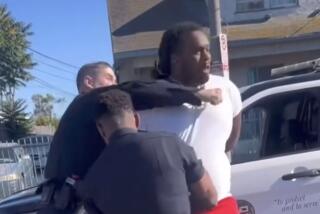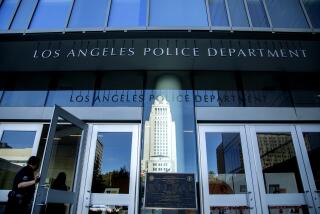LAPD Must Drop CRASH in Order to Regain Public’s Trust
- Share via
My informal survey began shortly after the Rampart scandal came to light. I asked virtually every gang member who came into my office at Jobs for a Future seeking employment, free tattoo removal or a redirected life, the same question. Had they ever had a bad experience with an officer from LAPD’s Community Resources Against Street Hoodlums, or CRASH, unit? No one said “No.”
All shared firsthand accounts of gun and “dope” plantings, prolonged beatings and being deposited by officers in the heart of rival gang territory. One young man’s interrogation consisted of being lifted off the ground and having his head rammed repeatedly into a target drawn on the wall by the inquiring CRASH officer. He showed me the scars. A 17-year-old was detained by an officer in pleasant conversation for 25 minutes, until the clock struck 10 p.m.--and then was handed a curfew violation ticket. At 9:30 p.m., he had been heading home--a half-block away.
They all had stories; most had several. We can see the events at Rampart as a crisis requiring yet again the mere removal of the bad apple, the rogue cop. Or, we can seize this moment as an opportunity to abandon, finally, a failed and misguided policing approach.
Our first clue, 20 years ago, that something was inherently wrong with this specialized gang unit came in its original acronym: TRASH (Total Resources Against Street Hoodlums). Civic leaders protested and the name was somewhat cynically altered to read “Community.” CRASH is surely not about the harnessing of community resources.
In the late 1970s, other cities, notably New York and Philadelphia, chose not to designate elite units to suppress gang activity. Their choices not only fostered a marked decrease in violent gang activity, but greatly benefited community-police relations. These cities could see that such a special unit, disassociated from regular patrol officers, could only serve to heighten the cohesiveness of gangs. Other cities were lured by the same start-up federal funds to embark on a path similar to CRASH’s, and wisely chose not to.
In Los Angeles, the policing of gang members has been left to CRASH, whose job it’s been to collect intelligence and crush gang activity and to do so by any means necessary. To hand this task to one elite unit of law enforcement is to foster an inevitable and unhealthy “occupying force” mentality. CRASH units have long had difficulty rising above an unsophisticated get-the-bad-guy mind-set. It is part of the air they breathe and a daunting challenge to overcome. As an officer told me once, “Our strategy is a simple one: Make life as miserable as we possibly can for the gang member.” This stance is pervasive and would seem to be endemic to CRASH units.
What undermines law enforcement in this city from protecting and serving the community well and effectively is not a scarcity of resources. Nor does the absence of laws that have teeth hold them back. Two things have kept LAPD from success in confronting the gang problem.
First, the rapid transfer and frequent turnover of officers from a given area has kept the police from knowing the community. The LAPD does not embrace community policing by sponsoring picnics, offering parenting classes or establishing after-school programs. The community needs to do those things. The power of community policing is in the relationship. This can happen only if an officer sticks around for a while. We don’t need a specialized gang unit. We need patrol officers who specialize in knowing their community.
Undeniably, CRASH has contact with gang members, and yet has no access to them. They have photographs and information cards and no knowledge. Knowledge is everything. A new model of policing needs to be explored. The Los Angeles Housing Authority police, for example, are given a reasonable area to patrol and remain there long enough to know and be known. The aerial view of gangs is less urgent than the street-level view. The beat officers of another era remind us of what the community needs to regain trust in its protectors.
The second obstacle to more effective policing can be found in the sometimes poisonous police culture that demonizes “the other” and holds in stark tension the “us versus them” dynamism. CRASH represents the most pronounced manifestation of this mind-set. “Getting the bad guy at all costs” is bad policing and bespeaks an unenlightened take on crime that was more prevalent when CRASH was conceived than it is now. We now know better.
Since the Rodney King incident, our local police division, Hollenbeck, to its credit, has made great strides in improving relations with the community. But the CRASH unit remains a problem. When bad police behavior is called to the high command’s attention, CRASH is often to blame (and usually a CRASH unit from a neighboring division). The captain and his lieutenants distance themselves: “Well, that’s CRASH. That’s not us.”
The Justice Department continues a “pattern and practice” review of the LAPD. We can only hope that the end of their monitoring will lead to the end of CRASH. Cities that have made progress in addressing the gang issue know that gangs are controlled only by a multifaceted approach. This effective strategy includes a combination of prevention, intervention and good policing. All this must be done with equal vigor, equal allocation of resources and with the greatest number of community stakeholders participating in its successful implementation.
The LAPD is ready and capable of fulfilling its part in the mandate to provide good policing, but CRASH is bad policing. You don’t try to fix it; you stop it.


